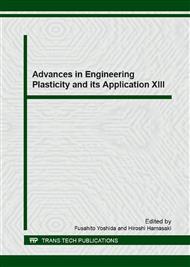p.255
p.261
p.267
p.275
p.281
p.287
p.293
p.299
p.305
Estimation of Residual Stress Change due to Cyclic Loading by Classical Elastoplasticity Model and Subloading Surface Model
Abstract:
The subloading surface model has been formulated and applied to the prediction of cyclic loading behavior. The material function prescribing elastic-plastic transition in the original subloading surface model has been extended so as to describe the inverse and reloading behavior and the strain accumulation in cyclic loading more accurately for steel. In the present paper, the extended subloading surface model was applied to the prediction of the change of the residual stress due to cyclic loading. The four-point cyclic bending test was performed for the specimen that had initial residual stress. The distributions of the residual stress before and after cyclic loading were measured by the X-ray stress measurement method. The simulation to the experiment was performed by the extended subloading surface model. The stress distribution after cyclic loading simulated by the extended subloading surface model was in good agreement with measured one, and was more accurate than that by the nonlinear isotropic/kinematic hardening model.
Info:
Periodical:
Pages:
281-286
Citation:
Online since:
December 2016
Authors:
Price:
Сopyright:
© 2017 Trans Tech Publications Ltd. All Rights Reserved
Share:
Citation:


